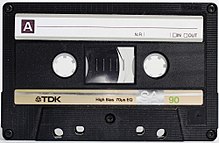
Back شريط سمعي Arabic Кампакт-касета Byelorussian Аудиокасета Bulgarian Kaseti BM Casset Catalan Audiokazeta Czech Casét Welsh Kassettebånd Danish Kompaktkassette German Κασέτα Greek
 | |
 A TDK SA90 Type II Compact Cassette | |
| Media type | Magnetic tape cassette |
|---|---|
| Encoding | Analog signal, in four tracks |
| Capacity | Most commonly 30, 45, and 60 minutes per side (C60, C90, and C120)[1] |
| Read mechanism | Tape head |
| Write mechanism | Tape head |
| Developed by | Philips |
| Usage | Audio and data storage (succeeded by CD) |
| Extended from | Reel-to-reel audio tape recording |
| Extended to | Digital Compact Cassette |
| Released | August 1963 Lifespan: 1963–present |
The Compact Cassette, also commonly called a cassette tape,[2] audio cassette, or simply tape or cassette, is an analog magnetic tape recording format for audio recording and playback. Invented by Lou Ottens and his team at the Dutch company Philips, the Compact Cassette was released in August 1963.[3]
Compact Cassettes come in two forms, either containing content as a prerecorded cassette (Musicassette), or as a fully recordable "blank" cassette. Both forms have two sides and are reversible by the user.[4]
Although other tape cassette formats have also existed—for example the Microcassette—the generic term cassette tape is normally used to refer to the Compact Cassette because of its ubiquity.[5]
Compact Cassettes contain two miniature spools, between which the magnetically coated, polyester-type plastic film (magnetic tape) is passed and wound[6]—essentially miniaturizing reel-to-reel audio tape and enclosing it, with its reels, in a small case (cartridge)—hence "cassette".[7] These spools and their attendant parts are held inside a protective plastic shell which is 4 by 2.5 by 0.5 inches (10.2 cm × 6.35 cm × 1.27 cm) at its largest dimensions. The tape itself is commonly referred to as "eighth-inch" tape, supposedly 1⁄8 inch (0.125 in; 3.17 mm) wide, but actually slightly larger, at 0.15 inches (3.81 mm).[8] Two stereo pairs of tracks (four total) or two monaural audio tracks are available on the tape; one stereo pair or one monophonic track is played or recorded when the tape is moving in one direction and the second (pair) when moving in the other direction. This reversal is achieved either by manually flipping the cassette when the tape comes to an end, or by the reversal of tape movement, known as "auto-reverse", when the mechanism detects that the tape has ended.[9]
- ^ "Museum Of Obsolete Media". 19 November 2015. Archived from the original on 3 May 2016. Retrieved 29 April 2016.
- ^ Mark Pernice (23 December 2015). "Opinion: Our Misplaced Nostalgia for Cassette Tapes". New York Times. Retrieved 17 June 2024.
- ^ Dormon, Bob (30 August 2013). "Are You for Reel? How the Compact Cassette Struck a Chord for Millions". The Register. Archived from the original on 2 August 2020. Retrieved 6 August 2022.
- ^ "Learn about Tabs-In or Tabs-Out Shells and Leaders". nationalaudiocompany.com. Archived from the original on 9 August 2017. Retrieved 9 August 2017.
- ^ "How to Identify Your Audio Cassette Tape Formats". digitalcopycat.com. Retrieved 13 September 2022.
- ^ Brian, Marshall (April 2000). "How Tape Recorders Work". HowStuffWorks. Retrieved 10 October 2015.
- ^ "Car Cartridges Come Home", pp.18-22, HiFi / Stereo Review's Tape Recorder Annual 1968, retrieved 22 May 2023. (Detailed diagram of a Fidelipac cartridge on p.20, with comparison to Lear Jet 8-track cartridge and Phillips cassette diagrams on p.21; extensive expert discussion of cassette, and comparisons to competitors, on pp.21-22.)
- ^ Cite error: The named reference
TDK specswas invoked but never defined (see the help page). - ^ "Part 7: Cassette for commercial tape records and domestic use". International standard IEC 60094-7: Magnetic tape sound recording and reproducing systems. International Electrotechnical Commission, Geneva.